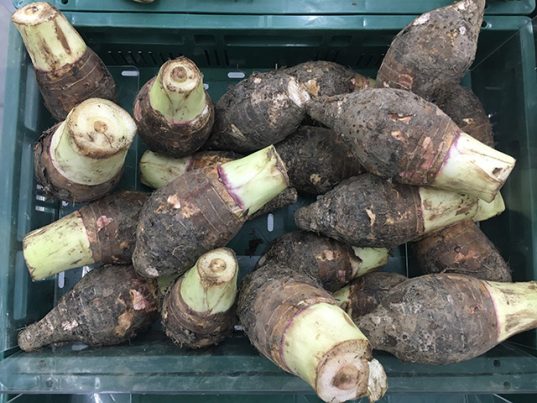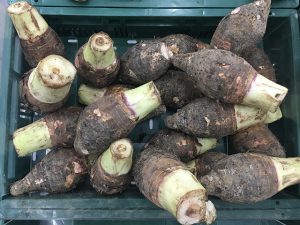Taro – sources, health benefits, nutrients, uses and constituents at NaturalPedia.com
Friday, August 18, 2017 by Earl Garcia
http://www.naturalpedia.com/taro-sources-health-benefits-nutrients-uses-and-constituents-at-naturalpedia-com.html

Taro is a starchy crop that is native to Southeast Asia and India. The crop is a staple food in the said regions as well as in Africa, China, the Caribbean, and Hawaii. According to The Kitchn website, both the leaves and the root can be consumed as food, but are highly toxic in their raw form. The crop is a distant relative of potatoes.
List of known nutrients
As with other tubers, taro is an excellent source of important nutrients that help enhance the body’s overall health. An entry posted on the Nutrition Value website lists the many essential components found in taro such as:
- Alanine
- Alpha-carotene
- Arginine
- Aspartic Acid
- Beta-carotene
- Beta-cryptoxanthin
- Calcium
- Choline
- Copper
- Cystine
- Folate
- Glutamic Acid
- Glycine
- Hexadecanoic Acid
- Histidine
- Iron
- Isoleucine
- Leucine
- Lysine
- Magnesium
- Manganese
- Methionine
- Monounsaturated Fatty Acids
- Niacin
- Octadecenoic Acid
- Pantothenic Acid
- Phenylalanine
- Phosphorus
- Phytosterols
- Polyunsaturated Fatty Acids
- Potassium
- Proline
- Riboflavin
- Saturated Fatty Acids
- Selenium
- Serine
- Sodium
- Thiamin
- Threonine
- Tryptophan
- Tyrosine
- Valine
- Vitamin A
- Vitamin B6
- Vitamin B12
- Vitamin C
- Vitamin D
- Vitamin E
- Vitamin K
- Zinc
Medicinal uses for taro
Taro is best known for its beneficial effects on the digestive system, which are largely due to its high fiber content. According to the Organic Facts website, a single serving of taro provides as much as 27 percent of the recommended daily intake of fiber. The crop’s rich fiber supply is found to facilitate bowel movement, cleanse the digestive tract, and enhance the overall gastrointestinal health. Taro is known to prevent a plethora of digestive conditions such as excess gas, bloating, and cramping as well as constipation and diarrhea.
Likewise, the superfood’s high fiber content helps in the prevention and management of diabetes. The crop is shown to regulate the release of glucose and insulin in the bloodstream. This, in turn, allows for the effective management of the body’s glycemic index and subsequently lowers the odds of developing diabetes. In people who already have the disease, the superfood helps prevent harmful fluctuations in blood sugar levels.
Taro is also an excellent source of potassium. The mineral is essential in relieving stress and pressure on both the arteries and blood vessels. This means that taro is an important component in maintaining a healthy cardiovascular profile. Aside from this, the high potassium content in taro is useful in improving cognitive function and facilitating fluid transfers between membranes and tissues.
In addition, the rich iron and copper supply in taro facilitates red blood cell production and prevents the onset of anemia. Aside from this, the superfood’s abundant beta-carotene and cryptoxanthin levels help stave off various eye conditions such as macular degeneration or cataracts. Likewise, taro is notably high in vitamins A and E that bolster overall cellular health and wards off a host of skin disorders.
Moreover, taro is shown to contain high levels of vitamin C that fortifies the body’s immunity. Taro is also an excellent source of essential vitamins and phenolic antioxidants that counter the negative effects of free radicals and reduce the risk of developing cancer. Cryptoxanthin, an important nutrient found in taro, is directly associated with lower odds of developing oral and lung cancers.
Body systems supported by taro
Taro is particularly beneficial in keeping a healthy digestive system. Likewise, the superfood helps maintain a healthy heart, brain, and eyes. In addition, the crop is found to bolster the body’s overall immunity and blood circulation. The plant is also known to improve skin health.
Ways to use taro
As a general rule, taro root can be cooked in the same manner as potatoes and sweet potatoes. This means that taro root can be fried, mashed, boiled, and roasted. An article posted on the Huffington Post website has curated several interesting taro recipes.
Where to learn more
Summary
Taro prevents cancer, diabetes, and various digestive issues.
Taro wards off cognitive issues, eye diseases, and anemia.
Taro promotes cellular health and mitigates skin disorders.
Taro helps maintain a healthy digestive profile.
Taro benefits the heart, brain, skin, and eyes.
Taro fortifies the body’s immunity and blood circulation.
Sources include:
Tagged Under: Tags: Taro







